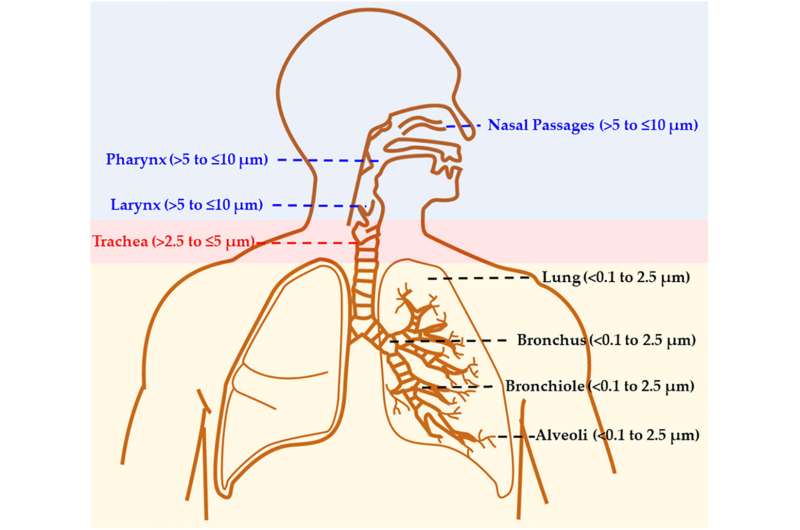Schematic representation of the respiratory system with the corresponding penetration of particles of different size. Credit: University of Kentucky
On Friday May 7, the United States Centers for Disease Control and Prevention (CDC) released new public recommendations to account for the coronavirus disease 2019 (COVID-19) airborne transmission. The CDC now accounts both transmission of the SARS-CoV-2 virus and infection causing COVID-19 disease can result from inhaled fine respiratory bioaerosol particles.
The new guidelines are completely aligned with scientific perspectives that are one year old at this time. On the contrary to airborne transmission, the previous official statement of the CDC was that the majority of infections occurred via close contact with large droplets and fomites. Back on April 7, 2020, a novel perspective from Marcelo Guzman, a chemistry professor at the University of Kentucky with an environmental science and engineering Ph.D. degree from Caltech was published as a preprint attempting to persuade scientists and public health officials to pay serious attention to the SARS-CoV-2 airborne threat. A second version of the preprint was later released on April 22, and finally passed peer-review for open access journal publication on December 8 in the International Journal of Health Planning and Management. This work unequivocally explained the danger of small bioaerosol particles that can remain in the air over time and penetrate different levels of the respiratory system.
To outline the recent changes, the CDC asserts that there is risk associated with inhaling the virus as a mode of transmission include deposition onto exposed mucous membranes as well as through directly touching the mucous membranes with dirty hands contaminated with virus. The implications are directly applicable to indoor environments such as the workplace, schools, and public transportation settings that lack adequate ventilation or air purification systems. Many follow up studies published during the last semester have revealed the role that small bioaerosol particles have on human health. For example, a recent open access paper in the International Journal of Environmental Research and Public Health published in January noted a list of recommendations to prevent the airborne transmission of SARS-CoV-2 virus. The study recommended efforts to control ventilation related spreading of the virus in restaurants, cruise ships, nursing homes, schools, kindergartens, offices, shops, and public transport to controlling the pandemic. The use of appropriate personal protective equipment, mechanical air filters, ultra-violet germicidal irradiation (UVGI), high-efficiency particulate air (HEPA) filters and ion generators, was recommended.
More information: Marcelo Guzman, Bioaerosol Size Effect in COVID-19 Transmission, April 7, 2020, www.preprints.org/manuscript/202004.0093/v1, DOI: 10.20944/preprints202004.0093.v1.
Marcelo I. Guzman, Bioaerosol Size Effect in COVID-19 Transmission, April 22, 2020, www.preprints.org/manuscript/202004.0093/v2, DOI: 10.20944/preprints202004.0093.v2.
Marcelo I. Guzman. An overview of the effect of bioaerosol size in coronavirus disease 2019 transmission, The International Journal of Health Planning and Management (2020). DOI: 10.1002/hpm.3095
Mahdieh Delikhoon et al. Modes of Transmission of Severe Acute Respiratory Syndrome-Coronavirus-2 (SARS-CoV-2) and Factors Influencing on the Airborne Transmission: A Review, International Journal of Environmental Research and Public Health (2021). DOI: 10.3390/ijerph18020395
Journal information: International Journal of Environmental Research and Public Health
Provided by University of Kentucky
























